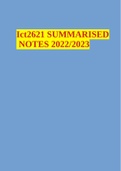Summary
Summary Ict2621 SUMMARISED NOTES 2022/2023
- Course
- Institution
Ict2621 SUMMARISED NOTES 2022/2023 CHAPTER 01: INTRODUCTION IT: Combination of hardware, software and services that people use to manage, communicate and share information. SYSTEMS ANALYSIS AND DESIGN: Step-by-step process for developing high-quality IT systems. INFORMATION SYSTEM: Combines t...
[Show more]



